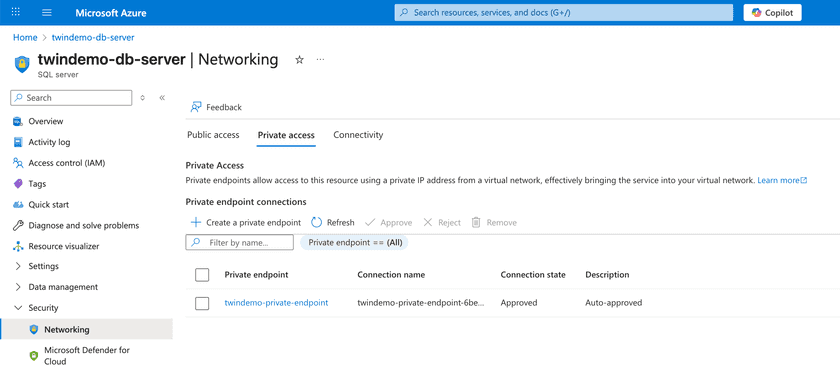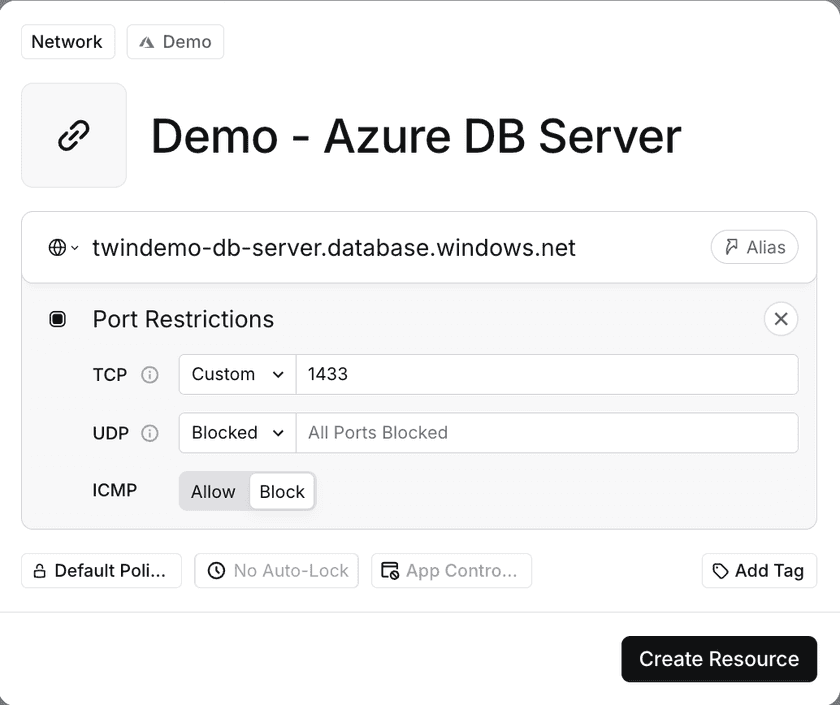Azure SQL Database Access with Twingate
Securely connect to Azure SQL Database or other Azure-managed databases using Twingate
Azure SQL Database Access with Twingate
Azure offers a variety of managed databases — Azure SQL Database, Cosmos DB, Database for PostgreSQL/MySQL/MariaDB, and more.
Best practice is to keep these services on private networks to minimize exposure and improve performance.
Twingate routes database traffic through secure Connectors, letting you enforce firewall or Private Endpoint restrictions without exposing your database publicly.
- Azure SQL Database: Securing Databases
- Self-hosted SQL Server on Azure VMs
- Optional: Securing Azure Portal Access
Prerequisites
- Remote Network & Connector – Create a Remote Network in Twingate and deploy at least one Connector:
- For private endpoints, place Connectors inside the same VNet as your database and use their private IP addresses in firewall rules.
- For public endpoints (when unavoidable), capture each Connector’s public IP address for allow-listing.
- Database instance – Either an Azure-managed database (e.g. Azure SQL Database) or self-hosted SQL Server running in Azure.
Tip: Use Azure Private Endpoint for Private Connectivity
If your database supports Azure Private Endpoint:
- Your Connector connects to a private IP address inside your VNet.
- All traffic stays on Microsoft’s internal backbone, bypassing the public internet entirely.
- No need to allowlist Connector public IP addresses — access is automatically restricted to your VNet.
See Microsoft’s Private Endpoint docs for service-specific setup.
Azure SQL Database: Securing Databases
Azure SQL Database enforces IP-based firewall rules. When using the public endpoint, the service sees only the Connector’s public egress IP address.
Step 1 - Configure Azure Private Connectivity
-
Disable Allow Azure services unless all Azure resources should connect (this adds
0.0.0.0/0). -
If using Private Endpoint, skip public IP rules and verify DNS resolves to the private IP address.

Disable Public Access 
Create a Private Endpoint with the Connector's VNet being the Source and DB being the destination 
Ensure DB Server is using Private Endpoint
Step 2 – Create a Twingate Resource
-
In the Twingate Admin Console, create a Resource for your Azure SQL Database host:
- Host:
<servername>.database.windows.net(found under Database -> Overview -> Server name) - Port:
1433
- Host:
-
Assign access to the relevant user group(s).

Create a Twingate Resource for DB Server
Step 3 – Connect to the database
With the Twingate Client running:
sqlcmd -S myserver.database.windows.net -U <username> -P <password> -d <database># EXAMPLE QUERY:1> SELECT * FROM Employees;2> GOEmployeeID FirstName LastName JobTitle HireDate----------- -------------------------------------------------- -------------------------------------------------- -------------------------------------------------- ---------------- 1 Alice Johnson Developer 2021-05-10 2 Bob Smith Manager 2019-03-22 3 Charlie Brown Analyst 2022-01-15Or use Azure Data Studio, SSMS, or any SQL client.

(Optional: If Public Access is Necessary) – Configure firewall rules in Azure
-
In the Azure Portal, navigate to your SQL Server → Networking → Firewall rules.
-
Add a server-level firewall rule for each Connector’s public IP address:
- Start IP = End IP = Connector’s public IP address.
- Server-level rules apply to all databases on the server.
-
For tighter scope, create database-level firewall rules via T-SQL:
EXECUTE sp_set_database_firewall_rule@name = N'TwingateConnector',@start_ip_address = '1.2.3.4',@end_ip_address = '1.2.3.5';
Self-hosted SQL Server on Azure VMs
For SQL Server, PostgreSQL, MySQL, MongoDB, etc. running on Azure VMs:
- Assign the VM a private IP address and deploy a Connector in the same VNet.
- In NSGs or host firewall, allow inbound traffic on the DB port from the Connector’s private IP address.
- Create a Twingate Resource for the VM’s private IP address and port.
- Connect using standard clients via Twingate — no public IP address exposure needed.
Optional: Securing Azure Portal Access
The Azure Portal (portal.azure.com) manages databases, billing, and resources. You can gate access with Twingate through SSO.
Tip: Combine with SSO for Identity-based Control
If your organization uses SSO (Azure AD, Okta, etc.), you can also gate portal.azure.com behind SaaS App Gating for identity-based access control.
Troubleshooting Database Connections
If you’re having trouble connecting to your database via Twingate, check the following common issues:
-
Firewall denies connection – Ensure that the Connector’s IP address is present in either a server‑level or database‑level firewall rule. Remember that Azure SQL checks database‑level rules first, then server‑level rules.
-
Too many server rules – If you exceed the 256 server‑level rule limit, move to database‑level rules or aggregate Connector IP ranges into CIDR blocks.
-
Port blocked – Verify that port 1433 is open on your local firewall and corporate proxies.
-
Slow Connections: Check the health of your Connectors and make sure there are no firewall rules blocking access to the database.
-
Timeouts: Verify your Connectors are online, reachable, and properly configured.
-
Twingate Recent Activity: In the Admin Console, open Recent Activity for the Resource to see what’s happening:
-
DNS Failed: The Client sent traffic to the Connector, but the Connector couldn’t resolve the hostname. Ensure the DNS hosted zone is tied to the VPC, the DNS server is defined as a Twingate Resource (if self-hosting), or there’s a valid route from the Connector to the DNS server.
-
Connection Failed: The Client captured the traffic, sent it to the Connector, and the Connector tried but couldn’t reach the destination. Check that a route exists between the Connector and database, IP allow lists are correct, and firewall/security group rules allow the port on both ends.
-
No Activity: The Client didn’t send traffic to the Connector. Make sure the Client is running, you have access to the Resource, and no other VPN is hijacking the connection.
-
For more help, see Microsoft’s Configure a server-level IP firewall rule and our Troubleshooting guide.
Related Resources
Last updated 5 days ago